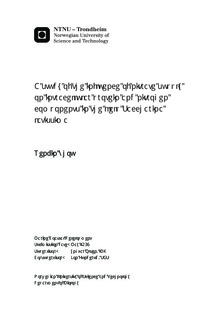A study of the influence of nitrate supply on intracellular protein and nitrogen components in the kelp Saccharina latissima
Master thesis
Permanent lenke
http://hdl.handle.net/11250/245488Utgivelsesdato
2014Metadata
Vis full innførselSamlinger
- Institutt for biologi [2596]
Sammendrag
Saccharina latissima were cultivated in tanks with three different levels of nitrate supply. The temperature was around 12 to 18 ℃ and salinity was around 24 to 29 during the experiment. Seaweeds cultivated at Medium N concentration (29.0±4.6μg/l) showed the fastest growth rate among the three treatments, and the growth rate of seaweeds at High N concentration (143±13μg/l) was not significantly higher than that at Low N concentration (18.1±1.5μg/l). Seaweeds cultivated at High N concentration showed a significantly higher level of intracellular DIN (0.22±0.02mg/g of dry weight), DON (1.4±0.1mg/g of dry weight), Protein (103.8±1.9mg/g of dry weight), and total-N (2.3±0.1% of dry weight) in the tissue than that grown at Low N and Medium N concentration (p<0.05). The concentration of nitrate in the water for Medium N treatment was 29.0±4.6μg/l, which was significantly higher than that grown in Low N treatment (18.1±1.5μg/l) (p<0.05), but the gap of nitrate level for these two treatments was not big. Seaweeds cultivated at Low N concentration did accordingly not have a significant lower level of DIN (0.05±0.11mg/g of dry weight), DON (0.40±0.08mg/g of dry weight), Protein (80.6±5.1mg/g of dry weight), and total-N (1.4±0.1% of dry weight) in the tissue compare with the seaweeds cultivated at Medium N concentration (p>0.05). Intracellular DIN, DON and protein were positively correlated (p<0.05) to the ambient nitrate concentration during growth.The elemental C/N ratio (weight) ranged from 13.7 mgC·(mgN)-1 for the plants grown in High N concentration (Day 42) to 27.7 mgC·(mgN)-1 in the Low N concentration (Day 62). Overall, at high nitrate supply, plants showed lower C/N ratio. The protein-to-nitrogen conversion factor for High N concentration (4.63±0.32 protein·N-1) was significantly lower than that in Low N concentration (5.78±0.35 protein·N-1) (p<0.05).
